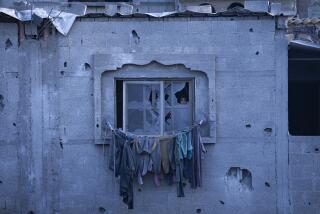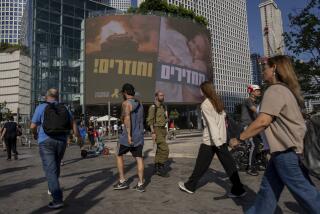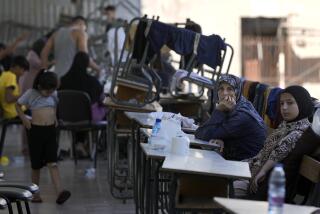As Dust Settles, Turks Take First Steps of Long Journey : Disaster: Life begins to return to one city devastated by quake. But daily routine is about food, shelter, coping.
- Share via
ADAPAZARI, Turkey — With the drama of the earthquake receding, life on Harmanli Street is beginning again.
The smell of bread wafts from the corner bakery. A man sifts through the ruins of his home. The cafe serves coffee and tea, and girls stand in line for shoes.
Like thousands of people in the cities east of Istanbul, the residents of Harmanli Street are emerging from the shocks of Turkey’s catastrophic earthquake. People they loved are dead. Their homes are buried in rubble.
With their lives changed forever, the survivors are trying to move on, striking up a new rhythm in a different world. It’s a world of tent cities and queues, of salvaging and rebuilding. Things that were, no longer are, and the future promises hardship and doubt.
“I don’t know what I’m going to do, but I need to be here working,” Celalettin Cihangir said as he stripped the wood from his crumpled home. “What else can I do?”
A retired 65-year-old with lively eyes, Cihangir fared better than most of his neighbors. His home and shop were flattened but his family survived. They now live with relatives in a village outside town.
Like many here, Cihangir has made no plans for his future, but he is going to make them. After an afternoon of work, he paused to consider his pile of planks.
“Perhaps I’ll use them to build my next home,” he said.
Harmanli Street runs through the center of Adapazari, a city of 200,000 and one of the hardest hit by the earthquake. The temblor killed at least 5,000 people here and forced an additional 50,000 from their homes. Once part of the city’s thriving commercial center, Harmanli Street is a corridor of crumbled apartments and buildings stuck at odd angles to the sky.
In the days after the quake, people across western Turkey’s industrial belt focused on survival and death. They dug themselves out of the rubble. They buried their children and looked for food. They acted with a grim determination, born of need and shock.
The mood seems to be changing along Harmanli Street, as the first patterns of a new era reveal themselves. There is more life than there has been in many days, but there is also more pain, and also more problems. Men gather in the cafes, unshaven and unwashed, since the pipes are broken and the water is off. Volunteers stir vats of soup before lines of people who have never had to ask for handouts. Everywhere, damaged buildings carry the government order emblazoned by inspectors: “Urgent: Destroy.”
A poster tacked to a telephone pole asks for help in finding a man named Hasan Bekcan, age 45, who hasn’t been seen since he pulled himself from the wreckage of his home. “It is believed that he lost his memory,” the poster says.
Nazni Cag, 54, has reopened his shoe repair shop just across from Cihangir’s ruined home. To his surprise, Cag has as many shoes as he can handle--so many, in fact, that he is running out of material. He has 10 pairs of shoes to fix and five pairs of heels. Cag hasn’t heard from his suppliers since the quake, so he’s planning a dash to Istanbul.
“I’ll get some heels, nails, some leather,” he said between drags on his cigarette. “I am somebody who depends on my shop.”
Up and down Harmanli Street, people speak of the same sort of challenges. Halim Yaman, who runs the Tonatim Bakery, gave away 3,000 loaves of bread in the days after the quake but recently discovered that all of his suppliers were knocked out of business.
“I’m worried about flour,” Yaman said.
Muzaffer Kurtulus, who just reopened his appliance shop, sat inside trying to imagine why anyone would buy a stove or a refrigerator without even having a house.
“People have bigger problems,” Kurtulus said.
At the tent city up the road, the director, Ali Kahraman, bemoaned the lack of beds, ordered the construction of a TV hall and promised parents he’d find toys for the children. Those are just a few of his problems, he said.
“Ninety-five percent of Adapazari has been erased from the map,” Kahraman said.
Huseyin Erisir, the block captain for the local government, sat in a storefront office along Harmanli Street and listened to people’s complaints. Erisir said the problems have changed in the two weeks since the earthquake.
“Right after the earthquake, I went to the mayor and said: ‘What are we going to do with all the corpses?’ ” said Erisir, a small man with a large mustache. “Now people ask me, ‘Where can I can get food?’ ”
Erisir sat beneath a portrait of Kemal Ataturk, a movie star look-alike who founded Turkey’s modern secular state. Like his hero, Erisir is an optimistic man, and he offered encouraging words to the people who came to his office.
“Things are getting better day by day, hour by hour,” he said.
There is still no electricity or water on Harmanli Street, and most everything else is scarce. People wait in line for everything: There are separate lines for food, water and clothes, and also for diapers and underwear.
Necati Polat, 30, grabbed a handful of clothes from the back of a relief truck and paused to see what he had: a black turtleneck, a pair of checkered pants, a dinner jacket and a flowered shirt--all different sizes. The quake destroyed Polat’s house, and his family’s clothes are buried inside. He lives with his wife and son in a tent.
“Every day, I wake up and look for queues,” he said. “It takes up most of my day. I never know what I’ll find, or where I’ll find it.”
Polat exudes a good-natured fatalism about his predicament, but most people find it harder to be upbeat.
At the Emirdag tent city just outside town, the first thing many new arrivals tell the relief workers is that they have loved ones still buried in the rubble.
At night, many people refuse to sleep under a roof, even if it is only made of canvas. Children draw pictures of smashed buildings and rescue helicopters, and others “play earthquake” by burying their dolls under rocks and then saving them.
“He doesn’t sleep. He cries a lot. He is hyperactive. He doesn’t eat anything,” Gulcin Kesebir said as she cradled her 3-year-old son, Onur, outside a tent set up for psychological counseling. “Before the earthquake, he was a happy baby.”
Even as much of Harmanli Street begins to move forward, some of those who suffered in the earthquake still cannot turn their gazes from the past. Sadettin Cakirsoy, 47, sat with two friends on some chairs they had managed to pull from the wreckage of their homes.
All day long, Cakirsoy stared across the street at his flattened home. His wife was crushed, survived, and then died in the hospital. Trucks and people hurried past him.
“I can’t think of anything,” Cakirsoy said.
More to Read
Sign up for Essential California
The most important California stories and recommendations in your inbox every morning.
You may occasionally receive promotional content from the Los Angeles Times.










